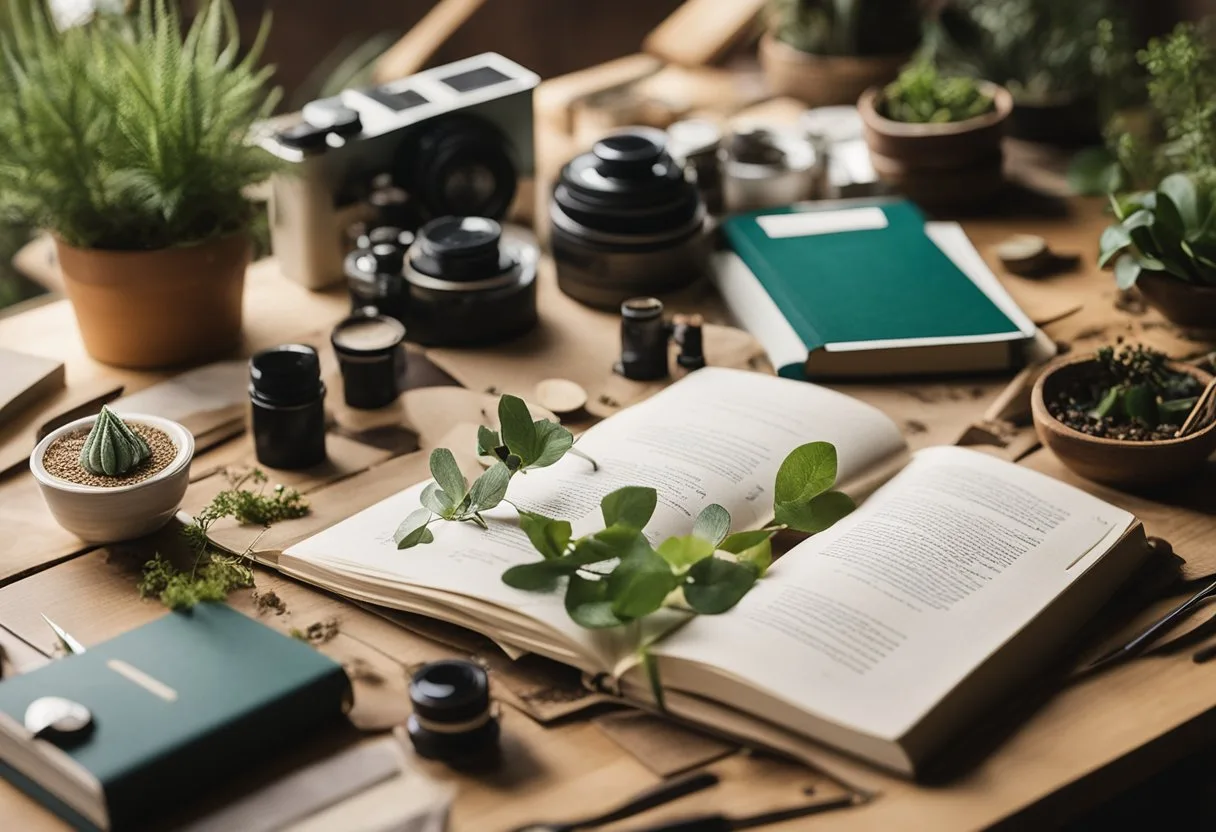Nature journaling is a wonderful way to connect with nature and experience the joy of observing the natural world. A nature journal is a personal record of observations, thoughts, and experiences in nature. It can be used for art, science, or simply as a way to document the beauty and wonder of the natural world. In this blog post, I will share with you 35 nature journal examples to inspire your next journaling entry.
If you’re looking to get started with nature journaling, there are many examples available online to inspire and guide you. These examples range from simple sketches and notes to detailed scientific observations and analyses. Some nature journal examples focus on the art of observation, while others explore the science of the natural world. Regardless of your interests, there are nature journal examples available to help you get started on your own nature journaling journey.
Getting Started with Nature Journaling
Nature journaling is a fantastic way to connect with nature and enhance your overall focus and observation skills. Whether you’re a seasoned artist or a beginner, nature journaling can be a fun and rewarding experience. In this section, you’ll learn how to get started with nature journaling, including choosing your materials and finding your focus.
Choosing Your Materials
One of the essential things you’ll need for nature journaling is a good quality sketchbook or notebook. You can use any sketchbook or notebook that you like, but it’s best to choose one that is durable and has high-quality paper that can handle different types of media.
When it comes to writing materials, you can use pens, pencils, or a combination of both. Pencils are great for sketching and adding details, while pens are ideal for adding color and writing notes. You can use any type of pen or pencil that you like, but it’s best to choose ones that are waterproof and fade-resistant.
Finding Your Focus
Before you start nature journaling, it’s essential to find your focus and determine what you want to observe and record. You can choose to focus on a specific area, such as a local park or nature reserve, or a particular type of flora or fauna.
When observing nature, it’s essential to pay attention to the details and take notes on what you see. You can record the colors, shapes, and textures of plants and animals, as well as any other interesting features or behaviors. It’s also helpful to take note of the weather and other environmental factors that may impact the ecosystem.
Nature journaling is a fun and rewarding way to connect with nature and enhance your observation and memory skills. With the right materials and focus, anyone can become a nature journaling enthusiast.
35 Nature journaling examples

- Sketch the outline of a leaf and note its characteristics.
- Observe and record the behavior of birds at a feeder.
- Press flowers or leaves and document where you found them.
- Describe the sensory experiences of a walk in the woods.
- Illustrate the stages of a plant’s life cycle.
- Measure the growth of a plant over time.
- Compare different types of seeds and their dispersal methods.
- Draw the insects you see in a garden and research their names.
- Listen to bird calls and try to transcribe or describe them.
- Paint a watercolor of a landscape or natural scene.
- Collect soil samples and note their textures and colors.
- Write a poem inspired by a natural phenomenon, like a thunderstorm or a sunny day.
- Photograph a natural event and describe what you observed.
- Identify and diagram the parts of a flower or plant.
- Trace the path of a creek or river and note any wildlife.
- Map the constellations you can see from your backyard.
- Record the changing tides and their times.
- Count the number of a specific type of plant in an area.
- Note the differences in bark textures on different trees.
- Watch and document a spider building its web.
- Time the sunrise or sunset and describe the changing light.
- Collect rocks and minerals and try to identify them.
- Observe the moon’s phases and note its position in the sky.
- Listen to the sounds of a forest at different times of the day.
- Write about your thoughts and feelings in a natural setting.
- Track the migratory patterns of a bird species.
- Measure the rainfall over a week and note the effects on local plants.
- Draw the footprints of animals you find in the mud or snow.
- Record the first frost and its impact on the garden.
- Observe the stars and make a wish on a shooting star, then write about it.
- Note the changes in a body of water throughout the seasons.
- Photograph different cloud formations and describe them.
- Collect leaves of varying colors and shapes during fall.
- Record the sounds during the dawn chorus of birds.
- Create a collage using natural materials collected on a hike.
Techniques and Skills Development
The Art of Observation
One of the most important skills in nature journaling is the ability to observe. Developing strong observation skills can help the journaler to notice details that might otherwise be overlooked. To improve observation skills, one can practice using their senses to take in the world around them. This can involve paying attention to colors, textures, shapes, and sounds. One can also practice using memory to recall details and to compare and contrast different observations.
Improving Your Sketching and Drawing
Sketching and drawing are important skills for nature journaling. They can help the journaler to capture the details of what they observe and to create a visual record of their experiences. To improve these skills, one can practice drawing from life and using different techniques such as shading and cross-hatching. One can also experiment with different materials such as pencils, pens, and watercolors to find the medium that works best for them.
Writing and Documenting Experiences
Writing is another important component of nature journaling. It can help the journaler to document their experiences and to reflect on what they have observed. To improve writing skills, one can practice describing what they see in detail and using descriptive language to convey the emotions and sensations that they experience. One can also experiment with different writing styles such as narrative, descriptive, and reflective writing to find the style that works best for them.
In order to develop these skills, it is important to practice regularly. By setting aside time each day or week to observe, draw, and write, one can develop a routine that will help them to improve their skills over time.
Seeking out resources such as books, online tutorials, and workshops can help the journaler to learn new techniques and to stay motivated. Ultimately, nature journaling is a lifelong learning process that can help the journaler to develop a deeper connection with the natural world.
Exploring the Natural World
Nature journaling is a way to connect with the natural world, and it can be done in a variety of ways. By exploring flora and fauna, noticing weather patterns and landscapes, and engaging with local biodiversity, one can gain a deeper appreciation for the environment.
Observing Flora and Fauna
One way to explore the natural world is by observing flora and fauna. By taking the time to notice the details of leaves, flowers, and other plant life, one can gain a greater understanding of the environment. Similarly, observing birds and other animals can provide insight into the behavior and habitats of local wildlife.
Noticing Weather Patterns and Landscapes
Another way to explore the natural world is by noticing weather patterns and landscapes. By observing the clouds, wind, and other weather phenomena, one can gain a greater appreciation for the forces that shape the environment. Similarly, noticing the features of the landscape, such as hills, valleys, and waterways, can provide insight into the geological history of the area.
Engaging with Local Biodiversity
Engaging with local biodiversity is another way to explore the natural world. By taking the time to learn about the plants, trees, and other wildlife in the area, one can gain a greater understanding of the ecosystem. Participating in citizen science projects can provide opportunities to contribute to scientific research and conservation efforts.
Exploring the natural world through nature journaling can be a rewarding and enlightening experience. By observing flora and fauna, noticing weather patterns and landscapes, and engaging with local biodiversity, one can gain a greater appreciation for the environment and the role that humans play in shaping it.
Reflecting and Connecting
Nature journaling is an excellent way to reflect on personal experiences and creatively express oneself. It provides a platform to connect with nature, express gratitude, and gain insights and knowledge about the natural world. In this section, we will explore how nature journaling can help individuals reflect and connect with nature, community, and themselves.
Personal Reflection and Creative Expression
Nature journaling allows individuals to reflect on their personal experiences and creatively express themselves. It helps individuals to slow down and appreciate the beauty of nature. By recording observations, thoughts, and feelings, individuals can gain a deeper understanding of themselves and their relationship with nature.
Through nature journaling, individuals can capture stories and memories that they can revisit and reflect upon in the future. It also provides an opportunity to express gratitude for the beauty and wonders of nature. By focusing on the positive aspects of nature, individuals can improve their mental and emotional well-being.
Sharing and Learning from the Community
Nature journaling is not just a personal activity; it can also be a social one. By sharing their journal entries with others, individuals can learn from the experiences and insights of others. It can also inspire individuals to explore new areas and observe new things.
Nature journaling communities can provide a platform for individuals to share their experiences and learn from others. It can also provide an opportunity to connect with like-minded individuals and develop a sense of community. By participating in nature journaling communities, individuals can gain insights and knowledge about the natural world and improve their nature journaling skills.
Nature journaling is an excellent way to reflect, connect, and learn. It provides a platform for personal reflection, creative expression, and community building. By nature journaling, individuals can gain insights and knowledge about the natural world and develop a deeper connection with nature and themselves.
Frequently Asked Questions
What materials are essential for starting a nature journal?
Starting a nature journal requires minimal materials. A journal or notebook, a pen or pencil, and a willingness to observe nature are the only essentials. However, some nature journalers prefer to use watercolor paints, colored pencils, or other art supplies to add color and depth to their entries.
How can nature journaling be incorporated into a child’s educational activities?
Nature journaling is an excellent way to incorporate hands-on learning into a child’s education. Parents and teachers can encourage children to observe and record their observations in a nature journal, which can help develop their observation skills, encourage curiosity, and foster a connection with nature.
What are effective techniques for capturing observations in a nature journal?
Effective techniques for capturing observations in a nature journal include using all of the senses, taking notes, sketching or drawing, and using descriptive language. It’s important to record as much detail as possible and to take the time to observe and reflect on what is being recorded.
What are the benefits of maintaining a nature journal for personal growth?
Maintaining a nature journal can have many benefits for personal growth, including increased mindfulness, improved observation skills, and enhanced creativity. Nature journaling can help reduce stress and anxiety, increase self-awareness, and foster a deeper connection with nature.
How do you structure a nature journaling session to maximize engagement and learning?
To maximize engagement and learning during a nature journaling session, it’s important to choose a location with a variety of natural elements to observe, encourage participants to use all of their senses, and provide prompts or activities to guide their observations. It’s also helpful to set aside dedicated time for reflection and discussion.
What are some creative prompts to inspire entries in a nature journal?
Creative prompts to inspire entries in a nature journal can include observations of seasonal changes, detailed descriptions of a particular plant or animal, or reflections on the emotional or spiritual connections one feels with nature. Other prompts can include drawing or sketching a landscape or creating a map of a particular area.




